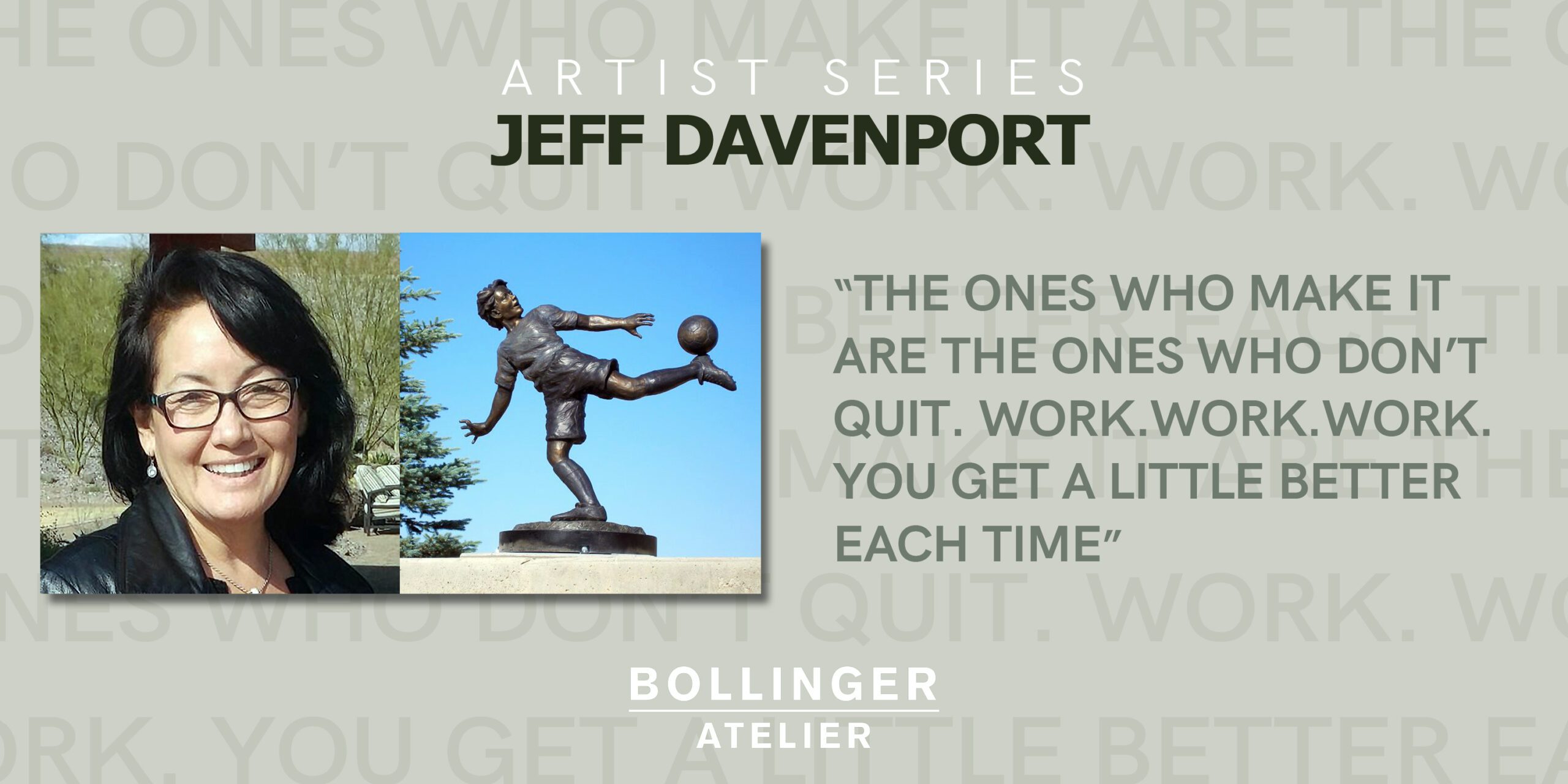Interview by Daniel Mariotti
Photos by Daniel Mariotti and Jeff Davenport
“THE ONES WHO MAKE IT ARE THE ONES WHO DON’T QUIT. WORK. WORK. WORK. YOU GET A LITTLE BETTER EACH TIME” -Jeff Carol Davenport
Getting lost to interview Jeff was worth it. At some point you lose phone signal and have to rely on “memory,” (or good foresight by Jeff emailing me directions). But then there are the distractions of the wildflowers and mountains that surround her neighborhood. But not house to house neighborhood. It’s more of house to wilderness to fresh air to house. The double doors to her converted garage studio open up into the expanse and let fresh air enter the space; where she is working on not only multiple sculptures but also paintings.
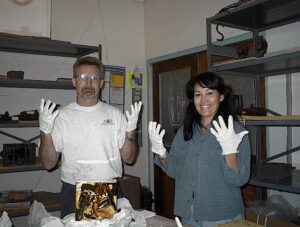
BA: What were you guys doing in this image?
Jeff: This is of the old foundry, Arizona Bronze. Tom looks so funny here. I wonder if we’re doing one of those castings for John Battenberg? We did have the ASU territorial cup. It came with those gloves and they were like, “you can’t touch the piece at all.” And so we had to wear these cotton gloves to handle it, so that might have been it when we were about to remold it.
BA: Did you work in every department?
Jeff: I just didn’t pour metal.
BA: Did you want to?
Jeff: I never really wanted to pour metal even when I went to college at NAU, there were people pouring but not a lot of the girls back then would pour the metal. I remember one girl poured metal and she was wearing a necklace and it started burning her but there was nothing she could do and I was like, you know, I’m good. But I did everything else. I loved making molds. I didn’t do patinas at the foundry, I did my own patinas. But that’s another thing. I had this mind block when it came to color.
BA: Do you still have that mind block?
Jeff: Not with painting, but when it came to bronze it seems like I would always burn the bronze, it would get too hot or too dark and it would just suck. I never seemed to get it quite right. Easy stuff, yeah, I can do a simple potash, ferric, and cupric.
BA: How did you get to the point of being an artist?
Jeff: I think growing up with my mom being Japanese. I had a whole different perspective of beauty and life. To me it was just growing up. My dad had our yard like the Japanese garden, because he was very interested in Asian arts too. So I was surrounded by a lot of Asian things and that just gave me a different perspective.
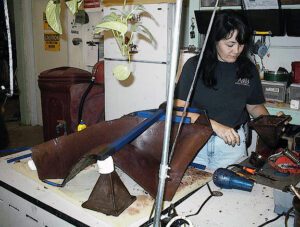
BA: You started working at Arizona Bronze before Tom (Bollinger) was the owner?
Jeff: I went to school at NAU, I was in their sculpture program, and after I graduated in 1980 I moved to Colorado. I found a foundry in Colorado, it was called Beyond Bronze. I worked there for three years and then my mother was going to open up her restaurant and she said we’d like you to come back and help. And I said Ok, I was up for a change anyway, Denver in the winter time was kind of cold for me. So I came back, helped with the restaurant, and when things got going I kind of left and wanted to go back into the foundry. So it was probably 1983 when I started for the D’Ambrosi family at Arizona Bronze. I worked on and off 25, 27 years at the foundry. And sometimes when Tom was there I’d work with Tom and then he’d be gone, and then eventually he wound up purchasing the foundry.
BA: What was that like, Tom becoming the owner?
Jeff: It really became more of a professional foundry. He was very determined to make a go of it and I think he’s done quite well. Before Tom was there it was a family owned business and people would come and trade beer for artwork and just hang out and use the sandblaster. It wasn’t that serious.
BA: How did your personal work change throughout your time as an artist?
Jeff: I like doing everything, this has been a struggle my entire life. I like contemporary work, I like non-objective work, I like figurative work. So whenever there was a need or where I saw I could do something, like somebody wanted something done, I would do it. When I worked at the foundry in Colorado we could basically cast whatever we wanted. So I made a lot of non-objective work in those days. Like all the time. Every break, every lunch period, whenever we had extra time, I would be working on projects. I did that my whole career. I think as an artist you have to be flexible in what you’re creating, but I always go back to the non-objective just for my own artistic expression.
BA: So then, what is the purpose of art for you? What does it give you?
Jeff: I think it’s just my freedom of expression. I’m not very verbose, there are some people that are very eloquent and can speak really well, but I can’t think that fast, so I think when I’m creating art that’s my creative expression.
BA: That makes sense especially seeing you working constantly; you’re trying to express yourself like a sculptural journal.
Jeff: Yeah, each little piece, I don’t have to talk, I can just create and it’s sort of an emotional feeling in the artwork, if that makes sense.
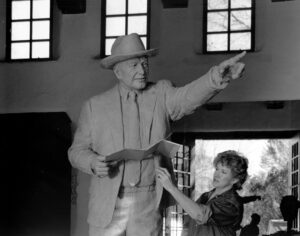
BA: What was one of your favorite pieces to work on when you were an artisan?
Jeff: I would say going to New Mexico and working on a Glenna Goodacre. We were in New Mexico making this crazy mold, and I wouldn’t say I enjoyed making the mold so much cause it was a kick your butt project, but just going to her studio and spending time talking to her and seeing her studio, that was probably one of my favorite times at the foundry.
But specifically artwork, I think I really liked people that did portraits. There was an older gentleman, he was an old doctor and he would just do portraits. But he didn’t have a very steady hand, so he would have to have us help him kind of “fix it”. So maybe helping an artist with their vision trying to make it like they wanted but they were not able to make it on their own, those were probably my favorite projects.
BA: It’s interesting because when you have sculptures in the public space it becomes a landmark where people can attach their stories to these objects and it becomes more relatable that way.
Jeff: That’s true; it does become more immediately impressive. Cause you don’t really have to think about it you can see it.
When I was a fourth grade teacher we took the students to the State Capitol and they saw the K-9 Police memorial I had made. I told them I had sculpted it. They knew they were going to go there, they knew they were going to see it, but it didn’t really click. Until we went there and saw the sculpture I had all 30 kids put papers in front of my face “can I have your autograph?” It’s like I’m the same person I was ten minutes ago and you didn’t need an autograph then. So I guess yeah they had to see that visual to understand, and now all of a sudden, I’m “famous”.
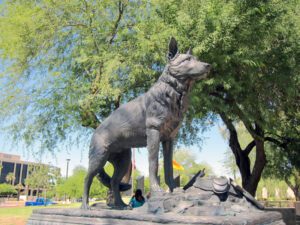
BA: Are you a perfectionist?
Jeff: I am, and this is a horrible thing, but everything I do, I wish I could do over.
BA: It’s funny because as a perfectionist you sculpt very quickly.
Jeff: I do. It makes me mad; I wish I could go slower. Even on the original Pat Tillman maquette, I probably had two weekends in it before I showed it to the client and then we made some adjustments. I’m almost embarrassed to tell people how fast I am because they’re going to think, “no way, you must not charge much because you’re so fast.” But when I get focused I can’t think of anything else.
BA: Do you have a routine for doing art?
Jeff: During the school year it’s very difficult. I usually don’t get home till maybe six. So by the time I get home I don’t have a lot of energy except maybe rolling a bad wax. In the summer time I really like to take classes. And once I take a class that gets me kind of rolling. Water color is my Achilles heel. I took a class and I thought maybe I can get at least a little bit better and ehhhh maybe I’ll stick with oil and sculpture. But I found out that you need really nice water colors for it to work. If you get the cheapy ones it’ll show.
BA: When did your decision to teach happen?
Jeff: I guess I was at the foundry too long. And my sister who was in education her whole life said, “oh, you’d be a good teacher.” And my husband saw a post in the ad in the paper, and it was a post baccalaureate program through ASU. And I said ok. And one of the things that is good about me, I guess, is that I really stick to things for a long time. I don’t just try things and then leave and, you know, forget about it. Being at the foundry for 27 years, that was such a commitment. I started out as a fourth grade teacher and that was like juggling. Then I taught middle school art. Middle school was not a happy place for me. And then after that I went back to teaching elementary school for a couple years and finally landed in high school. And the class that was available was ceramics, which I had taken ceramics but I didn’t know a whole lot of ceramics. But I was like yeah, I’m going to teach high school ceramics. So that was five years ago and I love it, and I love high school kids.
I’m probably getting off task on all your questions.
BA: That’s ok; all my questions are off task, nothing is in order. Do you have a dream project?
Jeff: I think my next project is always my dream project; I can’t wait to see what I can do next. I want an opportunity, I’m always looking for projects like artist calls, and it’s just very disappointing for me at this point because being in school it’s hard for me to pursue those jobs. I guess one of the things that would be really great would be to do like a monument about the Japanese internment camps that were South of Phoenix. That would be special.
BA: Do you think you are going to try to do this more full time at some point?
Jeff: I have been thinking of retiring a lot this year. When I meet people who are professional artist I pick their brain, how they transitioned from working to becoming an artist. People say you have to keep making art as you are working, and when you start selling enough to replace your income, that’s when you can do it. But I’m like, I can’t wait that long.
BA: What are your artistic inspirations?
Jeff: Texture. I love texture and sometimes I’ll randomly see texture or make texture. At school recently I’ve been making texture stamps. When I make them I can’t wait to use them. It’s not just the stamps, but little things like that inspire me. I saw a dead bird the other day and it was just so beautiful. It was iridescent and almost like it was in flight and I thought what can I do with this imagery? Insects inspire me, how their little legs move up and down inspire me. Pinterest. That’s where I get all of my ideas. Just kidding.
But I am always inspired, I think it goes back to growing up with that Asian influence and finding beauty in everything. I am always inspired.
(Taking a moment to look out the studio window)
I tell you living out here is inspiring.
BA: Why did you choose this area?
Jeff: When my son had gone to NAU we were living in Chandler at the time, I said when I went to NAU, one of the worst things was driving home on weekends all the way to Tempe, by the end of 4 years I hated that drive. So I said let’s move somewhere North so that it isn’t as far. And I had always loved this area up here and I knew people that lived up here. My grandmother lived in South Carolina and they always had acreage, so it wasn’t like they had a neighbor right next door right next door. And I always wanted that and have animals. So this was the perfect place. You’re just not under everybody. And the views are beautiful.
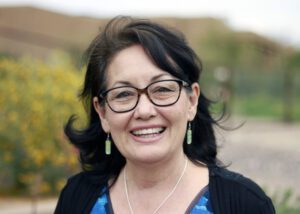
BA: What does community mean for you?
Jeff: There’s different communities in your life. My big community is with my students and inspiring them and seeing the art that they make. There’s also a community of friends I have that is very creative. And spending time with those likeminded people helps you create more. Having a community of artists is very valuable when you are an artist. For a long time I did not have that with my friends and that’s probably why I took so many art classes so I could meet people then. But yeah being around other creative people is very important for me.
BA: What do you think the purpose of being an artist is?
Jeff: I think it’s kind of maybe being a historian, I think providing art that tells a story is really important. I always think about my story behind each of my pieces, like what does it tells what does it say. I have kind of made my mark and told a little bit of my story so even when I’m gone I have a little bit of me out here telling my story.
BA: I agree, I feel like the strongest work connects people and opens up conversations.
Jeff: That’s very important. Not everybody likes what you make or your story but that’s ok they can have their own moments to talk about.
BA: Is there bad art?
Jeff: I’m an art teacher. Yes. There is bad art, but I think everyone should make art whether it is good or bad. There’s shock art, maybe people think that is bad, but there’s a place for it. It’s kind of like freedom of speech, you can tell your bad art story and if someone wants to listen to it and argue, that’s ok too.
BA: That makes sense. Just because something is “bad” doesn’t make it not valid. There was a reason for making it and that stands.
Jeff: Some days I think maybe my art is bad art, but whatever, I think at least I can get better. In making art you can only get better.
BA: What is success to you? What does it look like?
Jeff: When your mom says it is good. Then it is good.
BA: Do you have any vices?
Jeff: I don’t. It’s funny because as a highs school teacher, the kids are always asking me if I smoked pot or whatever and I’m like, I don’t even chew gum. I don’t really have anything but potato chips I guess. Maybe I’m boring. I’ve just been conservative, I guess I’m a simple person and I just like making art and creating art. Maybe that’s it, maybe making art is my vice. I’m kind of a workaholic. I wish I was more outlandish and people can say, “Oh yeah that’s an artist, look at her purple hair,” but really I’m just a simple person.
I think becoming an art teacher, and I know people say, people that can’t make art, teach. But being an inspiration to my students has also been an inspiration to me. So I’m happy with where I’m at.
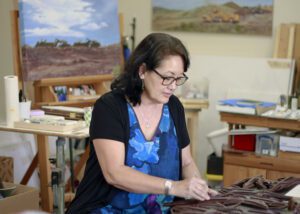
You can find Jeff’s work through her website HERE.
Also take a look at this process interview done by ASU taken at Bollinger Atelier for the Pat Tillman sculpture: https://asunow.asu.edu/20170830-sun-devil-life-pat-tillman-statue-unveiled-asu-stadium

